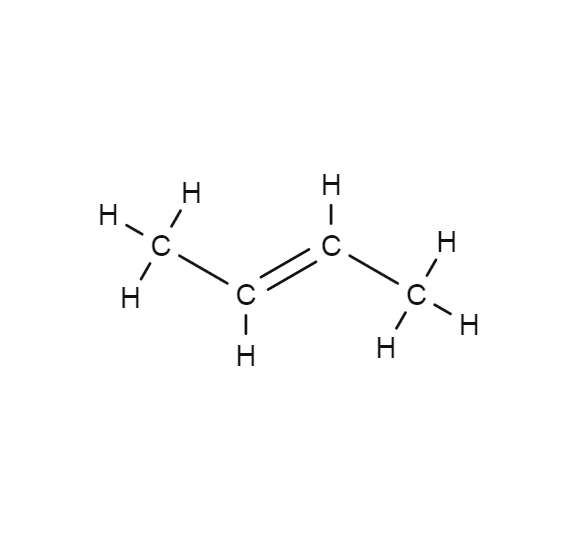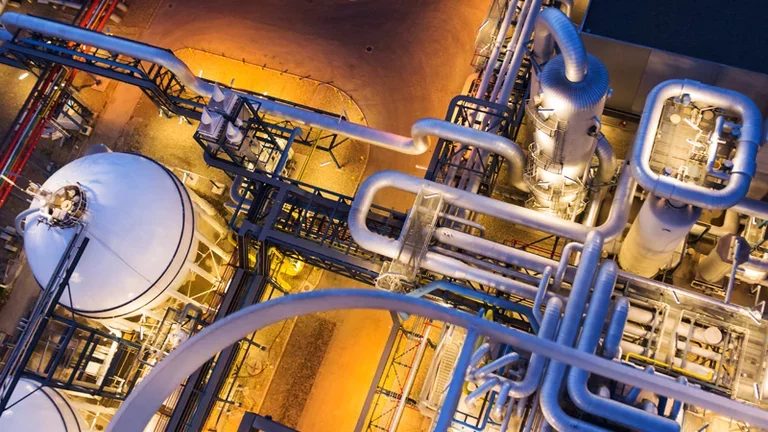
2-trans-Butene
- C4H8
- CAS Number 624-64-6
- UN1012 (gas)
Click & drag to move the 3D molecule
Liquid / Gas Volumes
Calculate the volume or mass of a quantity of gas or liquid
Liquid Phase
At boiling point at 1.013 bar
Gas Phase
In standard conditions (1.013 bar, 15°C)
Physical Properties
Molecule phase diagram showing the transition phases between solid, liquid and gas as a function of temperature and pressure
-
- Molar mass 56.106 g/mol
- Content in dry air /
-
Critical Point
- Temperature 155.45 °C
- Pressure 41 bar
- Density 235.74 kg/m³
-
Triple Point
- Temperature -105.55 °C
- Pressure 7.45E-4 bar
Pressure 1.013 bar
| Latent heat of fusion (at melting point) | 173.913 kJ/kg |
| Melting point | - 105.53 °C |
Pressure 1.013 bar
| Boiling point | 0.88 °C |
| Latent heat of vaporization (at boiling point) | 405.19 kJ/kg |
| Liquid density (at boiling point) | 626.45 kg/m3 |
| Gas density (at boiling point) | 2.605 kg/m3 |
| Specific gravity | 1.93 |
| Vapor pressure | 9.814E-1 bar |
| Compressibility factor Z | 9.651E-1 |
| Cp/Cv ratio γ | 1.1268 |
| Gas density | 2.4587 kg/m3 |
| Heat capacity Cp | 1.5845 kJ/(kg.K) |
| Heat capacity Cv | 1.4062 kJ/(kg.K) |
| Specific gravity | 1.93 |
| Specific volume | 4.068E-1 m3/kg |
| Thermal conductivity | 16.135 mW/(m.K) |
| Vapor pressure | 1.688 bar |
| Viscosity | 7.7419E-5 Po |
| Compressibility factor Z | 9.693E-1 |
| Cp/Cv ratio γ | 1.1209 |
| Gas density | 2.3659 kg/m3 |
| Heat capacity Cp | 1.6105 kJ/(kg.K) |
| Heat capacity Cv | 1.4367 kJ/(kg.K) |
| Specific gravity | 1.93 |
| Specific volume | 4.228E-1 m3/kg |
| Thermal conductivity | 17.106 mW/(m.K) |
| Vapor pressure | 2.3428 bar |
| Viscosity | 8.028E-5 Po |
Applications
Examples of uses of this molecule in Industry and Healthcare

Chemicals
2-Butenes have end uses in the production of butyl rubber. They are also used as feedstock for the production of propylene or mixed octenes.
Safety & Compatibility
GHS02
Flammable
GHS04
Gas under pressure
Autoignition Temperature, Flammability Limits & Flash Point
Europe (according to EN1839 for Limits and EN 14522 for autoignition temperature)
| Autoignition temperature (Chemsafe) | 324 °C |
| Lower flammability limit (IEC 80079-20-1) | 1.6 vol% |
| Upper flammability limit (IEC 80079-20-1) | 10 vol% |
US (according to ASTM E681 for Limits and ASTM E659 for autoignition temperature)
| Autoignition temperature (NFPA 325) | 324 °C |
| Lower flammability limit (NFPA 325) | 1.8 vol% |
| Upper flammability limit (NFPA 325) | 9.7 vol% |
Metals
| Aluminium | Satisfactory |
| Brass | Satisfactory |
| Monel | No data |
| Copper | No data |
| Ferritic Steel | Satisfactory |
| Stainless steel | Satisfactory |
| Zinc | No data |
| Titanium | No data |
Plastics
| Polytetrafluoroethylene | Satisfactory |
| Polychlorotrifluoroethylene | Satisfactory |
| Polyvinylidene fluoride | Satisfactory |
| Polyvinyl chloride |
Significant swelling, change of mechanical properties
Not recommended
|
| Ethylene tetrafluoroethylene | No data |
| Polycarbonate | No data |
| Polyamide | Satisfactory |
| Polypropylene | Satisfactory |
Elastomers
| Butyl (isobutene- isoprene) rubber |
Significant swelling and modification of the properties of the material
Not recommended
|
| Nitrile rubber | Satisfactory |
| Chloroprene |
Significant swelling
Not recommended
|
| Chlorofluorocarbons | No data |
| Silicone |
significant swelling and modification of the properties of the material
Not recommended
|
| Perfluoroelastomers | Satisfactory |
| Fluoroelastomers | Satisfactory |
| Neoprene | No data |
| Polyurethane |
Significant swelling, change of mechanical properties
Not recommended
|
| Ethylene-Propylene |
Significant swelling and modification of the properties of the material
Not recommended
|
Lubricants
| Hydrocarbon based lubricant |
Significant loss of mass
Not recommended
|
| Fluorocarbon based lubricant | Satisfactory |